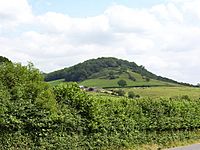Twinhills Woods and Meadows facts for kids
| Site of Special Scientific Interest | |
 |
|
| Area of Search | Somerset |
|---|---|
| Coordinates | 51°11′11″N 2°38′02″W / 51.18631°N 2.63380°W |
| Interest | Biological |
| Area | 21.2 hectares (0.212 km2; 0.082 sq mi) |
| Notification | 1990 |
Twinhills Woods and Meadows is a very special natural area in Somerset, England. It covers about 21.2 hectares, which is like 52 football fields! This amazing place is home to ancient woodlands, open grassy fields, and thick hedges. It's officially known as a Site of Special Scientific Interest (SSSI). This means it's protected by law because it has rare plants, animals, or unique natural features.
This site was recognized as special in 1990. It's a fantastic spot for nature lovers and hikers. You can even walk through it on a famous long-distance path called the Monarch's Way.
Why is Twinhills Woods and Meadows Special?
Twinhills Woods and Meadows is a mix of different natural habitats. It has very old woodlands, which are called ancient semi-natural woodland. These woods have been around for hundreds of years. There are also different types of grassland here. Some are "neutral" grasslands, and others are "calcareous" grasslands. This means the soil has different amounts of lime, which helps different kinds of plants grow.
The site also has mature hedges and areas where shrubs grow. All these different parts create a perfect home for many kinds of wildlife.
Amazing Butterflies!
One of the most exciting things about Twinhills Woods and Meadows is the huge number of butterfly species you can find here. So far, 26 different types of butterflies have been seen! This makes it a really important place for these beautiful insects.
Some of the butterflies you might spot include:
- The grizzled skipper (Pyrgus malvae)
- The white-letter hairstreak (Satyrium w-album)
- The green-veined white (Pieris napi)
- The brown argus (Aricia agestis)
- The marbled white (Melanargia galathea)
- The silver-washed fritillary (Argynnis paphia)
- The marsh fritillary (Eurodryas aurinia)
These butterflies need specific plants to lay their eggs on and to feed from. The mix of woodlands and grasslands at Twinhills provides everything they need to survive and thrive.
Walking the Monarch's Way
If you love to hike, you'll be interested to know that the Monarch's Way long-distance footpath goes right through Twinhills Woods and Meadows. This path is 625 miles (1,000 km) long! It follows the escape route taken by King Charles II in 1651 after he lost the Battle of Worcester. Walking a part of it through Twinhills is a great way to explore this natural wonder.

